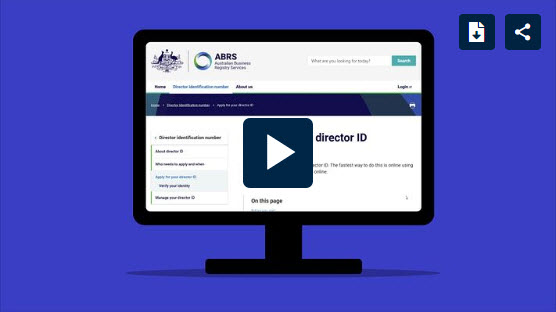Director Identification Numbers – time is ticking!
Do you have an SMSF with a corporate trustee or are you a director of a company? Do you know you have to register for a director identification number (director ID) by 30 November 2022? Legislation was previously introduced resulting in new obligations for company directors requiring them to obtain a personal director identification number (‘Director ID’) before 30 November 2022. As a company director, you are required to personally apply for a Director ID. Note this also includes where you are a director of a company acting as a trustee (such as the corporate trustee of your SMSF or family trust). While our office can help you in understanding your new Director ID obligations, unfortunately we cannot make the application on your behalf (although we are happy to assist if and when required). Please see below for the registration process to follow. Once you have successfully applied for, or if you have previously obtained, your Director ID, please supply a copy to our office. How do I apply for a Director Identification Number? You can apply by calling 13 62 50 or online. To apply by calling 13 62 50: Call 13 62 50 (may be a wait time of around 5 mins) The overall process should not take more than 5 minutes, once your call is answered. You will need to have your personal TFN and ID ready. ID will need to be 1 Primary & 1 Secondary document (You will be asked for details on documents ie. Document numbers, expiry dates etc) Primary documents can be: • Australian full birth certificate (extracts and commemorative certificates are not acceptable) • Australian passport (including passports that have expired in the past two years) • Australian citizenship certificate or extract from a Register of Citizenship by Descent • ImmiCard • Visa (if you are using a foreign passport but you are still in Australia) Secondary documents can be: • Medicare card • Australian driver’s licence or learner’s permit. This must show your photo and signature, and the address on the card must match your details on the form. You will then be asked answer a couple of questions, such as; • The name of the bank where you hold an account that earned interest in the last 2 years • Your mobile phone number • The name of your Accountant This should then complete the process and you will be given your Director ID number. To apply online: There are 3 key steps to apply for your director ID online. Step 1: Set up myGovID If you do not already have a myGovID you will need to set this up before you can apply for your director ID online. You can find information on how to setup your myGovID by downloading the app at: https://www.mygovid.gov.au/set-up Step 2: Gather your documents You will need to gather some information that the ATO already knows about you to verify your identity. You will need your tax file number, your residential address held by the ATO, and information from two of the following documents: • Bank account details • ATO notice of assessment • Super account details • Dividend statement • Centrelink payment summary • PAYG payment summary Most of this information can be downloaded from your myGov account so it may be worthwhile linking to this service ahead of applying for your director ID. Note, myGovID is different to your myGov account. Your myGov account allows you to link to and access online services provided by the ATO, Centrelink, Medicare and more, while myGovID is an app that enables you to prove who you are and to log in to a range of government online services, including myGov. Step 3: Complete your application Once you have a myGovID and information to verify your identity, you are ready to apply for your director ID. You can click on the following link to start the application process. The application process is quick and should take you less than 5 minutes. https://abrs.gov.au/persons/ui/secure/start/applyForDirectorID?action=applyfordirectorid Further information about the application process, and step-by-step instructions, can be found via this link: https://www.abrs.gov.au/director-identification-number/apply-director-identification-number The information provided in this article is general in nature only and does not constitute personal financial advice.

